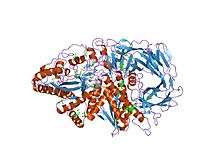Glycoside hydrolase family 38
| Glycosyl hydrolases family 38 N-terminal domain | |||||||||
|---|---|---|---|---|---|---|---|---|---|
 golgi alpha-mannosidase ii | |||||||||
| Identifiers | |||||||||
| Symbol | Glyco_hydro_38 | ||||||||
| Pfam | PF01074 | ||||||||
| Pfam clan | CL0158 | ||||||||
| InterPro | IPR000602 | ||||||||
| SCOP | 1o7d | ||||||||
| SUPERFAMILY | 1o7d | ||||||||
| CAZy | GH38 | ||||||||
| |||||||||
| Alpha mannosidase, middle domain | |||||||||
|---|---|---|---|---|---|---|---|---|---|
 golgi alpha-mannosidase ii | |||||||||
| Identifiers | |||||||||
| Symbol | Alpha-mann_mid | ||||||||
| Pfam | PF09261 | ||||||||
| InterPro | IPR015341 | ||||||||
| SCOP | 1o7d | ||||||||
| SUPERFAMILY | 1o7d | ||||||||
| |||||||||
| Glycosyl hydrolases family 38 C-terminal domain | |||||||||
|---|---|---|---|---|---|---|---|---|---|
 golgi alpha-mannosidase ii | |||||||||
| Identifiers | |||||||||
| Symbol | Glyco_hydro_38C | ||||||||
| Pfam | PF07748 | ||||||||
| Pfam clan | CL0103 | ||||||||
| InterPro | IPR011682 | ||||||||
| SCOP | 1o7d | ||||||||
| SUPERFAMILY | 1o7d | ||||||||
| CAZy | GH38 | ||||||||
| |||||||||
In molecular biology, glycoside hydrolase family 38 is a family of glycoside hydrolases.
Glycoside hydrolases EC 3.2.1. are a widespread group of enzymes that hydrolyse the glycosidic bond between two or more carbohydrates, or between a carbohydrate and a non-carbohydrate moiety. A classification system for glycoside hydrolases, based on sequence similarity, has led to the definition of >100 different families.[1][2][3] This classification is available on the CAZy(http://www.cazy.org/GH1.html) web site,[4] and also discussed at CAZypedia, an online encyclopedia of carbohydrate active enzymes.[5]
Glycoside hydrolase family 38 CAZY GH_38 comprises enzymes with only one known activity; alpha-mannosidase (EC 3.2.1.24) (EC 3.2.1.114).
Lysosomal alpha-mannosidase is necessary for the catabolism of N-linked carbohydrates released during glycoprotein turnover. The enzyme catalyzes the hydrolysis of terminal, non-reducing alpha-D-mannose residues in alpha-D-mannosides, and can cleave all known types of alpha-mannosidic linkages. Defects in the gene cause lysosomal alpha-mannosidosis (AM), a lysosomal storage disease characterised by the accumulation of unbranched oligo-saccharide chains.
A domain, which is found in the central region adopts a structure consisting of three alpha helices, in an immunoglobulin/albumin-binding domain-like fold. The domain is predominantly found in the enzyme alpha-mannosidase.[6]
References
- ↑ Henrissat B, Callebaut I, Mornon JP, Fabrega S, Lehn P, Davies G (1995). "Conserved catalytic machinery and the prediction of a common fold for several families of glycosyl hydrolases". Proc. Natl. Acad. Sci. U.S.A. 92 (15): 7090–7094. doi:10.1073/pnas.92.15.7090. PMC 41477
 . PMID 7624375.
. PMID 7624375. - ↑ Henrissat B, Davies G (1995). "Structures and mechanisms of glycosyl hydrolases". Structure. 3 (9): 853–859. doi:10.1016/S0969-2126(01)00220-9. PMID 8535779.
- ↑ Bairoch, A. "Classification of glycosyl hydrolase families and index of glycosyl hydrolase entries in SWISS-PROT". 1999.
- ↑ Henrissat, B. and Coutinho P.M. "Carbohydrate-Active Enzymes server". 1999.
- ↑ CAZypedia, an online encyclopedia of carbohydrate-active enzymes.
- ↑ Hough E, McSweeney S, Schoehn G, Heikinheimo P, Helland R, Leiros HK, Leiros I, Karlsen S, Evjen G, Ravelli R, Ruigrok R, Tollersrud OK (2003). "The structure of bovine lysosomal alpha-mannosidase suggests a novel mechanism for low-pH activation". J. Mol. Biol. 327 (3): 631–44. doi:10.1016/S0022-2836(03)00172-4. PMID 12634058.
This article incorporates text from the public domain Pfam and InterPro IPR000602
This article incorporates text from the public domain Pfam and InterPro IPR011682
This article incorporates text from the public domain Pfam and InterPro IPR015341